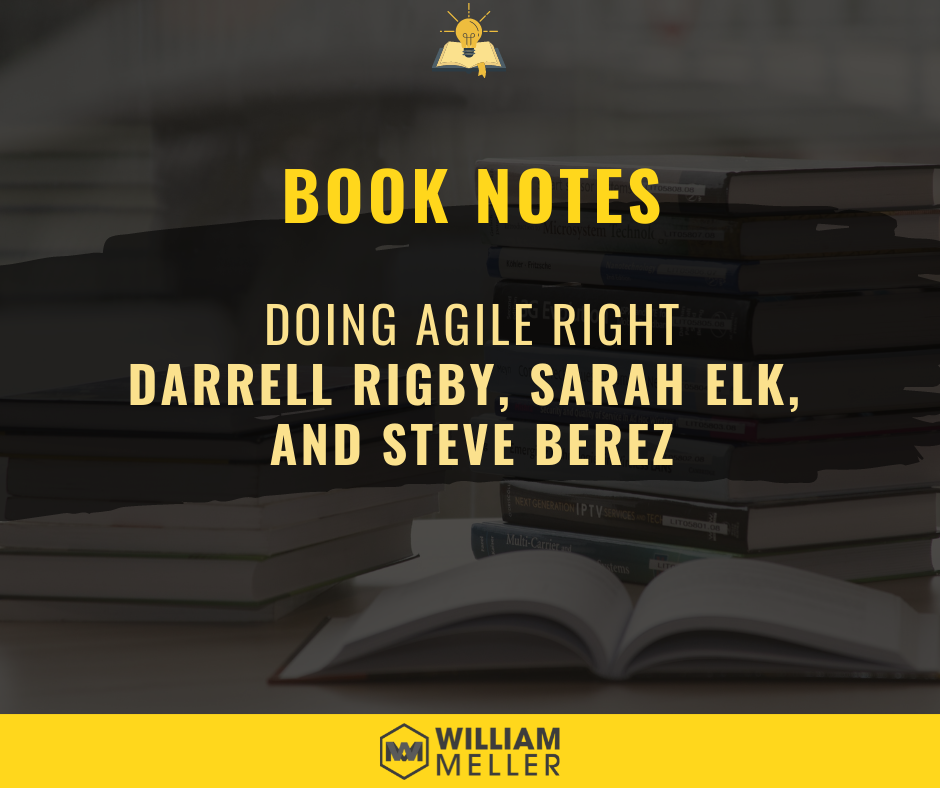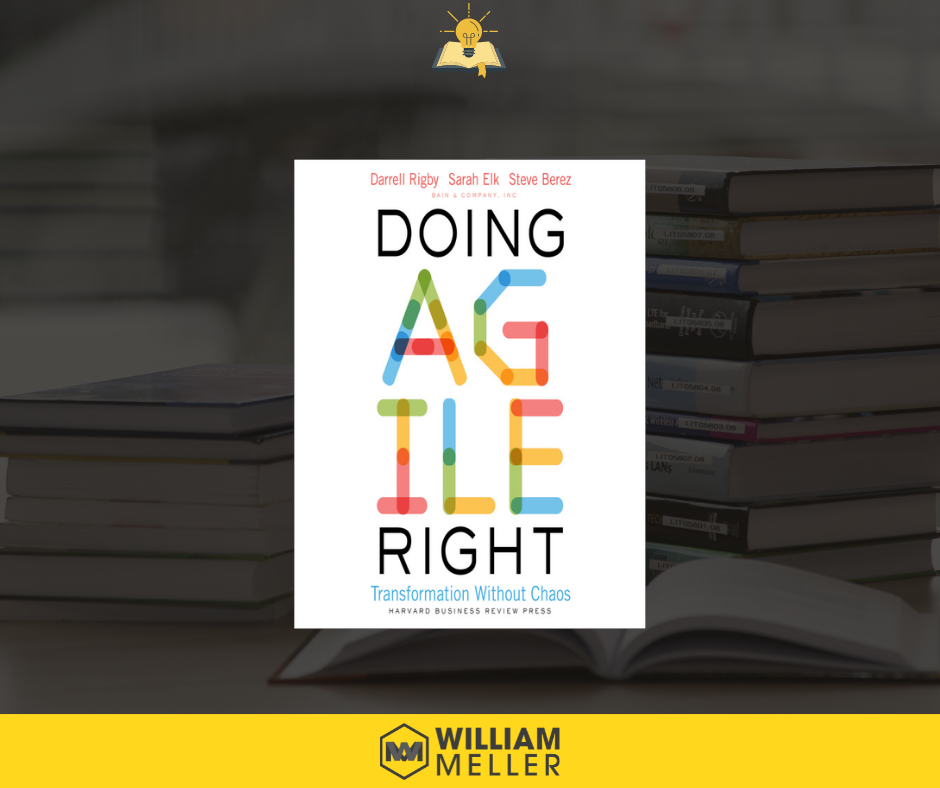
Agile isn't a goal in itself, it's a means to achieve high performance. Doing Agile Right is a must-have guide for any company trying to make the transition or to sustain agility.
Summary
Title: Doing Agile Right: Transformation Without Chaos
Author: Darrell Rigby, Sarah Elk, Steve Berez
Themes: Leadership, Management, Business, Agile, Software, Lean
Year: 2020
Publisher: Harvard Business Press
ISBN: 1633698718, 9781633698710
Pages: 256
According to Forbes, Agile continues to “eat the world”, with the five largest firms on the planet steadily increasing their market capitalizations, including three with trillion-dollar market capitalizations, it’s not surprising that there’s a torrent of books and articles about what’s involved in becoming agile.
For decades business leaders have been painfully aware of a huge chasm: They aspire to create nimble, flexible enterprises. But their day-to-day reality is silos, sluggish processes, and stalled innovation.
Today, agile is hailed as the essential bridge across this chasm, with the potential to transform a company and catapult it to the head of the pack.
Not so fast. In this clear-eyed, indispensable book, Bain & Company thought leader Darrell Rigby and his colleagues Sarah Elk and Steve Berez provide a much-needed reality check.
They dispel the myths and misconceptions that have accompanied agile's rise to prominence - the idea that it can reshape an organization all at once, for instance, or that it should be used in every function and for all types of work.
This comprehensive guide breaks down the key principles and practices of Agile, providing actionable steps for successfully integrating it into your company culture.

"Doing Agile Right" covers several key concepts, including:
The importance of creating a culture that supports Agile practices, including building trust and fostering collaboration among teams.
The need for clear and measurable goals, as well as regular check-ins and reviews to ensure progress is being made.
The use of data and metrics to track progress and make informed decisions.
The importance of effective leadership in implementing and maintaining Agile practices.
The role of experimentation and learning in the Agile process, and the need to be willing to adapt and change course as needed.
The need for a strong sense of ownership and accountability among team members.
The importance of creating a transparent and inclusive environment where all team members feel valued and heard.
The need to focus on delivering value to customers, and continuously seeking ways to improve the customer experience.
They illustrate that agile teams can indeed be powerful, making people's jobs more rewarding and turbocharging innovation, but such results are possible only if the method is fully understood and implemented the right way.
The key, they argue, is balance.
My Book Highlights:
"... In a truly agile enterprise, bureaucracy and innovation become partners. They create a system where both elements improve and where people in each camp collaborate to generate superior results. We’ll show how to harmonize the two in this book..."
"... There is an optimal level of change for every business, and for every activity within a business. Ideally, an agile business system would operate at the golden mean between change deficiency—leading to a static business system that adapts too slowly to survive—and change excess, creating a chaotic business system that constantly risks spinning out of control..."
"... Anyone contemplating it has to pass F. Scott Fitzgerald’s famous test of first-rate intelligence: “the ability to hold two opposed ideas in the mind at the same time and still retain the ability to function..."
"... Agile enterprises map the work that needs to be done to meet customer needs and deploy dedicated cross-functional agile teams to change the business..."
"... Talent system: Agile enterprises use performance-driven processes for determining how to acquire, deploy, assess, develop, reward, and inspire talent, and continuously improve the systems and approaches to people management..."
"... One more ingredient of fun: teaching and coaching others. Teaching—and watching others learn—is one of the most rewarding and satisfying human endeavors..."
"... One tactic for making the whole endeavor fun is to create and celebrate frequent wins..."
"... A critical tool for the team is a robust, adaptive backlog of opportunities that team members can tackle together. The backlog will give your team a realistic, itemized, fact-based vision of how much value is possible, and in what order the team should attack the work..."
"... The first step should be to create an agile leadership team, which will operate just like any other agile team..."
"... Agile enterprises create balanced systems that efficiently adapt to changing customer opportunities in order to deliver superior results..."
"... In an agile enterprise, executives do not focus on optimizing the performance of individual teams. They focus instead on improving the performance of the entire business system..."
"... We highly recommend lean production methods for improving operations. We do not recommend them for managing innovation..."
"... Lean is a source of considerable confusion because people apply the term to two very different approaches: lean production systems (also known as Lean Six Sigma), and lean product development (also known as a lean start-up)..."
"... Forming agile teams may not even require changing reporting lines for employees. Agile team members would still report to their home departments, but their managers would act as long-term professional development coaches rather than as day-to-day supervisors. Daily activities would be planned and executed with the teams..."
Every organization must optimize and tightly control some of its operations, and at the same time innovate.
Agile, done well, enables vigorous innovation without sacrificing the efficiency and reliability essential to traditional operations.
Chapters of the Book:
Introduction: The Unbalanced Company
Chapter 1 - How Agile Really Works
Chapter 2 - Scaling Agile
Chapter 3 - How Agile Do You Want To Be
Chapter 4 - Agile Leadership
Chapter 5 - Agile Planning, Budgeting, and Reviewing
Chapter 6 - Agile Organization, Structures, and People Management
Chapter 7 - Agile Processes and Technology
Chapter 8 - Doing Agile Right
Appendix A: A Leadership Team’s Agile Manifesto
Appendix B: Definitions of Operating Model Components
Appendix C: Research Notes Summary
The authors break down how agile really works, show what not to do, and explain the crucial importance of scaling agile properly in order to reap its full benefit.
They organize a road map for leading the transition to a truly agile enterprise.
Doing Agile Right is a must-have guide for any company trying to make the transition--or trying to sustain high agility.
Darrell Rigby is a partner in the Boston office of Bain & Company, where he heads the Global Innovation and Agile practices. He is a frequent speaker and writer on innovation, agile, and retail, and his research has been published in Harvard Business Review, the Wall Street Journal, Bloomberg Businessweek, the Financial Times, and other publications.
Sarah Elk is a partner in Bain's Chicago office, where she heads the firm's Global Operating Model practice.
Steve Berez is a partner in Bain's Boston office and a founder of the firm's Enterprise Technology practice.
I am incredibly grateful that you have taken the time to read this post.
Your support and engagement mean the world to me, and I truly appreciate your interest in the topics I write about.
I hope that you have found this post informative, educational and engaging.
If you are interested in reading more of my work, please visit other articles here on the website.
I promise to continue providing valuable and high-quality content for your enjoyment and education.
Thank you again for reading and I hope to see you soon!
Here are some related articles you may enjoy:
There are even more good things I've prepared for you!
Subscribe here to receive new posts in your Email!
Do you want to read some book notes and recommendations? Discover more here!
Do you want to have amazing weekly content curation? Discover more here!
Ready to make a positive impact?
Support my work by sharing my content with your network.
Your simple act of kindness can reach new heights and help spread valuable information.
Want to show your support in a tangible way? A virtual coffee is a small but mighty way to show your appreciation and give me the extra energy to keep crafting valuable content!



